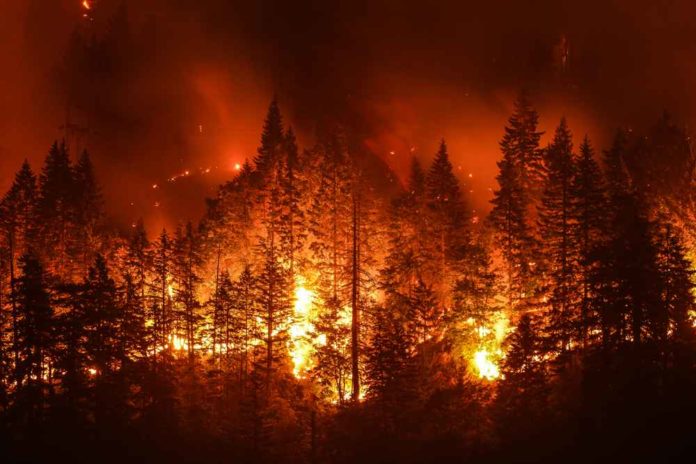Wildfires are a rapidly growing challenge – and businesses need better tools to manage risk. It is only the beginning of 2020 wildfire season and already there have been 20,351 US wildfires between January 1 and June 12. Compare this to 16,630 fires during the same period in 2019, according to National Interagency Fire Center (NIFC) .
While reinsurance and risk modeling experts work to predict wildfire-related risk and identify new trends such as increase in property development, changes in wildfire behavior, and increase in weather volatility, businesses can actively work to protect their properties and employees from a wildfire in seven steps.
- Create defensible space
Defensible space is both horizontal and vertical (low lying brush to bushes to low lying tree canopies to large tree canopies). The key is to disrupt continuity in the vertical dimension. Your property should be divided into three zones around your building.
Zone 1: 0 to 5 feet from the exterior wall of your building
This zone is closest to your facility, so it requires the most careful selection and intensive management of plants and materials.
- Install hard surfaces in this zone, such as a concrete walkway, or use noncombustible mulch products, such as rock
- Regularly water lawns and plantings to prevent dry
- Remove dead plant material from
- Remove plants adjacent to combustible siding and foundation vents, as well as plants under or next to windows, under-eave vents or interior
Zone 2: 5 to 30 feet from your building, or to the property line
Maintaining plants in this zone will help prevent fire from climbing (laddering) into the top portion of trees or shrubs and burning directly to your facility.
- Maintain trees and shrubs in well-spaced
- Remove dead plant material and lower tree
- Maintain trees by keeping a minimum horizontal spacing of 10 feet between crowns, with the distance increasing with increasing
- Prune limbs and branches to a height of up to 15 For shorter trees, pruning should not exceed 1/3 of the tree height.
Zone 3: 30 to 100 feet from your building, or to the property line
Maintaining plants in this zone will help reduce the energy of wildfire, slowing its advance to your building. Tree and brush spacing should force any fire in the tops of the trees, brush, or shrubs to drop to the ground.
- Remove dead plant material and tree branches from vegetation on a regular maintenance
- Create islands or groupings of
- Remove lower tree
- Maintain trees with a minimum horizontal spacing of 10 feet between crown
- Reduce organic fuel
Create a Vegetation Maintenance Plan (VMP) to reduce ignition sources. If using plants around the building, select ones with low combustibility characteristics such as high moisture content, low oil or resin content, deep roots with thick heavy leaves, and minimal production of dead vegetation. When developing a VMP, consult a landscape professional such as a forester, range manager, or natural resource specialist.
- Use noncombustible materials for building signage
Avoid materials such as wood, plastic and vinyl as they will act as fuel to further the spread of fire.
- Consider the exterior walls
Select exterior wall cladding made of non-combustible siding materials such as concrete and brick. Ensure the start of siding is a minimum of 6 inches above the ground.
- Consider the windows
Select windows that are dual-paned with tempered glass. For operational windows, install screens to cover sections that can open. Windows should be closed when wildfire threatens.
- Cover the roof with non-combustible material
Select roof covers with a Class A fire rating based on testing to ASTM E108 or UL 790. Class A fire rating means that the building material is highly resistant to fire and does not spread flames quickly. Select gutters and downspouts made of noncombustible materials such as aluminum.
- Inspect vents and clear fuel from roofs
Install a minimum of 1/16” and maximum of 1/8” non-combustible mesh screening over all vents to prohibit wind-blown embers from entering your building (1/4” mesh is ineffective, according to California Building Code Chapter 7A). Regularly remove debris from roof and gutters, since it can easily be ignited by wind-blown embers.
Taking these steps now will help mitigate risk to your business from a wildfire event. To learn more about wildfire risk and preparation, please visit the 2020 Wildfire Report.
Scott Steinmetz brings broad industry experience coupled with nearly three decades of practical experience in applied engineering and risk management consultancy.
He has been employed by Allianz for more than 23 years, holding positions in claims (forensic engineer and practice group leader), in underwriting (director of catastrophe management), in the risk office responsible for corporate catastrophe management and operational risk, in risk services as leader of MidCorp loss control engineering and as North America regional manager for MidCorp ARC. In these roles, Steinmetz has sponsored and promoted the concept of using expertise and knowledge-based insights to help improve the foundation and information on which organizations base analysis and financial decisions.
Before Allianz, Steinmetz practiced as an environmental engineer at a national environmental engineering company for more than six years, focused on design and implementation of pollution cleanup remedies for a variety of industrial clients.
In addition to these experiences and responsibilities, Steinmetz has served as an appointed international representative to the Allianz working group for sustainable development and the Allianz center of competence for climate change. He was also an appointed technical representative to the governor of California’s Alluvial Fan Task Force. Steinmetz serves as an associate member of the American Society of Civil Engineers and served as a member of the environmental assessment committee for the American Society of Testing and Materials.
Steinmetz holds a bachelor’s of science degree in agricultural engineering and a master’s of engineering degree in civil and environmental engineering from California Polytechnic State University, San Luis Obispo. He is a registered professional engineer in California.
Wildfire stock photo by Christian Roberts-Olsen/Shutterstock







